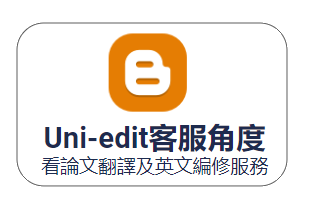難度:進階
征文的編輯們在編修英文論文時,常常需要糾正連字號的用法。能夠正確使用連字號代表作者的英文程度極佳,能透過這種標點符號的使用,讓寫作的細節更加清楚易懂。
連字號是一條短橫槓,能幫助讀者清楚區辨出文中哪一個是被修飾的字,常見於各種形式的英文學術寫作中。
一般人寫作時常會誤用連字號,這可能是因為它在口語上並沒有對應的符號,只有寫作時才會用到。妥善使用連字號能讓讀者在閱讀時更加流暢,避免語意不清的問題。
下面我們來看看一些常見的用法以及錯誤:
以ly結尾的副詞不使用連字號
正確: The highly toxic substance was handled carefully. (這個高毒性的物質處理得很妥當。)
錯誤: The highly-toxic substance was handled carefully.
名詞之後的複合詞不使用連字號
如果用來描述某事物的複合詞若位置出現在名詞之後,則不使用連字號(即使是出現在名詞前需使用連字號的複合詞也一樣)。
正確: The proposal was well documented. The professor said: "This really is a well-documented proposal."
錯誤: The proposal was well-documented.
正確: He has a 42-foot-long boat. His boat is 42 feet long.
錯誤: His boat is 42-feet-long.
動作的重複可用連字號表示
正確: We re-applied the coating. (我們在表面重複上漆。)
這句話的意思是說重複做上漆的動作。
寫數字時要加連字號
寫二十一或九十九這樣的數字、或表示數學上的幾分之幾時,需使用連字號。
正確: He is one-quarter Irish. (他有四分之一的愛爾蘭血統。)
正確: Twenty-one people participated in the experiment. (有二十一個人參加這個實驗。)
中斷的複合詞可使用連字號
在提到一系列類似的複合詞時,有時候我們會讓共同的複合詞結尾在句子最後才出現,這時連字號所扮演的功能,就是連接每個詞不同的開頭和大家共用的結尾。
正確: The third- and fourth-grade teachers met with the parents. (三、四年級的老師和家長見面。)
正確: Both full- and part-time employees will get raises this year. (全職和兼職的員工今年都會加薪。)
正確: We don't see many 3-, 4-, and 5-year-old children around here. (這邊三、四、五歲的小孩比較少。)
正確: Follow standard pre- and post-operative procedures. (操作前、操作後的步驟都按照標準程序進行。)
增加字首時使用連字號
在大寫的字前面加字首、或字首本身需要大寫時,必須使用連字號。另,在使用像self-, all-, and ex-這些字首時,也需要加上連字號。此外,字首結尾的字母若與字本身的第一個字母相同時,有時也需要加上連字號(不過不是必須)。
正確: A-frame, I-formation, self-control, anti-intellectual, de-emphasize, non-English
Special cases: unnatural, coordinate, cooperate
Download Tip Here:  如何正確使用連字號 (Part B)
如何正確使用連字號 (Part B)
Uni-edit English Writing Tip: How to use hyphens correctly (Part B)
Level of difficulty: Advanced
Editors at Uni-edit often need to correct the use of hyphens during English editing of manuscripts. Correct use of hyphens shows the author's advanced command of English and helps to make detailed descriptions clear.
The hyphen, which is a very short horizontal line that looks like this '-', is very helpful to disambiguate modified words, which will make your writing clearer. Hyphens are used often in all academic writing in English.
Hyphens cause writers more trouble than any other form of punctuation, except perhaps commas. This may be because the hyphen has no analogue in speech; it is punctuation created purely by the needs of print. The point of the hyphen is to avoid ambiguity for the reader.
Let's look at some common uses and misuses:
Rule: Do not hyphenate when the adverb ends in 'ly'
Correct: The highly toxic substance was handled carefully.
Incorrect: The highly-toxic substance was handled carefully.
Rule: Do not hyphenate compounds that come after the noun
Don't hyphenate most compound modifiers if they occur after the noun being modified, even if hyphenating them before the noun.
Correct: The proposal was well documented. The professor said: "This really is a well-documented proposal."
Incorrect: The proposal was well-documented.
Correct: He has a 42-foot-long boat.
Correct: His boat is 42 feet long.
Incorrect: His boat is 42-feet-long.
Use a hyphen for repeated actions
Correct: We re-applied the coating.
This means the coating was applied for a second time. The hyphen makes it clear for the reader that the ‘re’ means a repeated action.
Writing some numbers
Use a hyphen for writing numbers twenty-one to ninety-nine and fractions.
Correct: He is one-quarter Irish.
Correct: Twenty-one people participated in the experiment.
Suspended Compounds
With a series of nearly identical compounds, we sometimes delay the final term of compound until the last instance, allowing the hyphen to act as a kind of placeholder.
Correct: The third- and fourth-grade teachers met with the parents.
Correct: Both full- and part-time employees will get raises this year.
Correct: We don't see many 3-, 4-, and 5-year-old children around here.
Correct: Follow standard pre- and post-operative procedures.
Adding certain prefixes
When a prefix comes before a capitalized word or the prefix is capitalized, use a hyphen. The prefixes self-, all-, and ex- nearly always require a hyphen, and when the prefix ends with the same letter that begins the word, you will often use a hyphen, but not always.
Correct: A-frame, I-formation, self-control, anti-intellectual, de-emphasize, non-English
Special cases: unnatural, coordinate, cooperate (a journal or publisher may have house rules on whether or not to hyphenate these words)
END OF TIP



